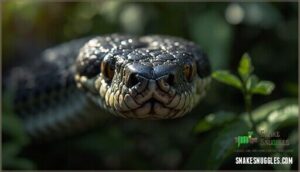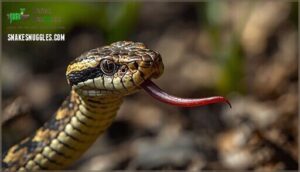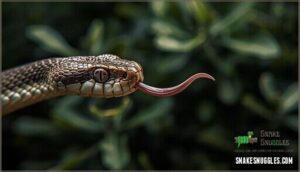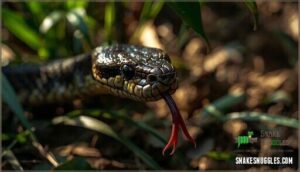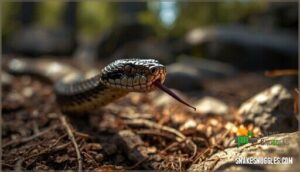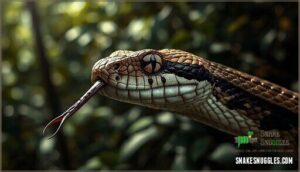This site is supported by our readers. We may earn a commission, at no cost to you, if you purchase through links.

Instead of tasting dinner the way you savor pizza, snakes rely on a hidden organ tucked in the roof of their mouth that reads chemical signatures like a molecular detective. This vomeronasal system doesn’t distinguish between "delicious" and "disgusting" the way your tongue does. It answers a more primal question: is this prey, predator, or potential mate?
Understanding how snakes detect food without conventional taste buds reveals just how radically different their sensory toolkit is from ours.
Table Of Contents
- Key Takeaways
- Snake Sensory Limitations
- The Role of a Snake’s Tongue
- Forked Tongue and Air Sampling
- The Jacobson’s Organ
- Snake Appetite and Behavior
- Snakes’ Sense of Smell
- Unique Snake Adaptations
- Frequently Asked Questions (FAQs)
- Do snakes have taste buds?
- Where do snakes taste?
- Do snakes taste like humans?
- Do lizards have taste buds?
- Why do snakes have more taste buds than lizards?
- Do snakes have taste receptors?
- Do snakes need to eat to survive?
- Do snakes have the ability to detect temperature changes?
- How do snakes find their prey?
- Is there any evidence that snake’s can sense human pheromones?
- Conclusion
Key Takeaways
- Snakes have virtually no taste buds (only about 20 on the roof of their mouth, none on their tongue), relying instead on the Jacobson’s organ—a specialized chemical detection system that identifies prey, predators, and mates through molecular signatures rather than conventional taste.
- The forked tongue functions as a stereo-smelling tool that samples air from two locations simultaneously, delivering chemical particles to the Jacobson’s organ with precision that allows snakes to track prey direction and location despite lacking traditional sensory organs like external ears or sharp eyesight.
- Snakes compensate for multiple sensory limitations (poor hearing, limited color vision, and minimal touch sensitivity due to hard scales) through an integrated system combining chemical detection, ground vibration sensing through jawbones, and in some species, infrared detection of temperature differences as small as 0.003°C.
- Their sensory system prioritizes survival efficiency over sensory experience—up to 80% of prey-acquisition behaviors stem from chemical detection rather than sight, with longer tongues directly correlating to improved scent tracking and hunting success across different snake species and environments.
Snake Sensory Limitations
If you think snakes are limited hunters, you’re in for a surprise. They can’t hear well, don’t see sharply, and can barely feel through their armor-like scales.
Here’s what makes their sensory world so different from ours.
Lack of Outer Ear, Eardrum, and Strong Eyesight
Unlike most animals you’re familiar with, snakes lack several key sensory organs that humans and other creatures rely on. They have no outer ear or eardrum, which means they can’t pick up airborne sounds the way you do. Instead, their jawbone picks up vibrations from the ground and channels them to the inner ear—a clever workaround that lets them detect movement between 50 and 1,000 Hz through bone conduction.
Their eyesight isn’t much better, especially in nocturnal species with smaller eyes and limited color vision. But here’s where sensory integration comes in: snakes compensate beautifully for these limitations. Some species even possess infrared detection abilities using pit organs.
Their sensory organs work together—vibration detection through the jawbone, chemical sampling via the tongue, and even thermal sensing in some species—to create a complete picture of their world. This sensory perception system makes them remarkably effective hunters, even without traditional ears or sharp vision.
Limited Sense of Touch Due to Hard Scales
Those same hard scales that protect snakes also create significant tactile limitations. Scale rigidity means your snake’s body can’t feel the world the way you do—those keratinized layers are like thick armor that blocks fine touch. Sensilla distribution is surprisingly sparse, with most snake bodies averaging fewer than 3 sensilla per square millimeter on mid-body scales. That’s a tiny fraction of the sensory organs you’d find in mammals.
Think of it this way: snakes traded touch for protection. This sensory trade-off makes perfect sense when you consider evolutionary adaptations. Why invest in widespread tactile sensitivity when you’re swallowing prey whole and moving mostly by scent? The sensilla that do exist cluster mainly on the head and face—exactly where snakes need them most for hunting.
Snakes traded touch for protection—why invest in tactile sensitivity when you swallow prey whole and hunt by scent?
So instead of relying on touch, snakes lean heavily on their other sensory perception systems. Their sensory organs work as a team: chemical detection through the tongue, vibration sensing through the jawbone, and in some species, infrared detection. It’s a masterclass in sensory adaptation. Snakes also possess specialized vibration-sensitive mechanoreceptors in their skin.
The Role of a Snake’s Tongue
You might’ve heard some wild stories about snake tongues, but let’s clear up what’s actually going on. A snake’s tongue isn’t a weapon, and it doesn’t work the way you’d expect for tasting or smelling.
Here’s what you need to know about how this fascinating tool really functions.
The Groove in The Top Lip for Tongue Movement
You’ve probably seen snakes tongue flicking with their mouths barely open. That’s possible because of a special groove in their top lip, called the lingual notch. This narrow channel lets the forked tongue dart in and out without opening the jaw wide.
The groove lines up perfectly with internal ducts that lead to sensory organs, enabling stereo-smelling—where each fork samples different spots for precise tracking. This evolutionary adaptation emerged around 90 million years ago, helping snakes navigate while keeping their mouths closed.
Dispelling The Myth of Snake Stinging With Their Tongue
That groove you just learned about doesn’t carry venom—despite a stubborn myth claiming otherwise. For centuries, people believed the forked tongue could sting like a bee. Early naturalists even mistook it for a weapon. But here’s the truth:
- The tongue is soft muscle covered in keratin, like your fingernails
- Venom flows only through hollow fangs, never the tongue
- High-speed cameras show tongue flicking behavior is purely for chemical sampling
- Thousands of handling observations confirm zero injuries from tongue contact
Snake tongue function is entirely sensory. The forked tongue collects airborne molecules, enabling snake sensory perception through harmless behavior. Debunking efforts by herpetologists have finally cleared up these anatomical impossibilities, proving the tongue sting myth false.
Lack of Smell Receptors and Taste Buds on The Tongue
When you watch a snake flick its tongue, you might assume it’s tasting the air—but that’s not quite right. Anatomical studies reveal snakes lack traditional taste buds on their tongues entirely. Instead of smell receptors or taste bud structures, the tongue functions purely for chemoreception reliance.
It collects chemical particles and delivers them to the Jacobson’s organ for processing. This tongue receptor absence represents evolutionary sensory trade-offs: vomeronasal compensation replaced conventional snake taste detection millions of years ago.
Forked Tongue and Air Sampling
You might wonder why a snake’s tongue has that distinctive split down the middle. That fork isn’t just for show—it’s a specialized tool that lets snakes sample air from two spots at once.
Here’s how tongue shape and length work together to help snakes track down their next meal.
Forked Tongue Collecting Air Samples From Different Directions
Think of it like having two sensors instead of one—snakes use bilateral scenting to pinpoint exactly where prey is hiding. When you watch a snake flicking its forked tongue, each tine collects scent particles from a slightly different spot in the air.
This stereo-smelling mechanism works like your ears comparing sounds to locate a noise, except snakes are tracking chemical cues. The tongue fluid dynamics are fascinating—each flick creates tiny vortices that pull molecules toward the tongue tips at about 3 meters per second, boosting scent collection by over 100 times compared to sitting still.
Through neurological integration, the brain compares signals from both sides to steer the snake toward prey with striking precision. These evolutionary adaptations transformed tongue flicking into one of nature’s most effective prey detection systems.
The Relationship Between Tongue Length and Scent Detection
Longer tongues directly improve a snake’s ability to follow scent gradients and locate prey with pinpoint accuracy. When a snake flicks its forked tongue, the length determines how much air volume it sweeps—longer tongues capture dramatically more scent particles per flick, sometimes boosting chemosensory sampling efficiency by up to 25% with just a 10% increase in length.
Here’s how tongue length shapes scent detection:
- Active foragers like colubrids have tongues 1.8 times longer (relative to body size) than ambush hunters, letting them track airborne scent trails across open terrain
- Neural processing gets sharper with length—each extra centimeter increases firing rates in vomeronasal receptor neurons, improving odor source accuracy
- Foraging modes drive evolution—species relying on trail-following developed tongues up to 26 times longer than sit-and-wait predators
- Snake tongue function links directly to habitat—aquatic species sport shorter tongues but compensate with enhanced receptor genes for water-soluble molecules
This tongue-length advantage explains why different species excel in their specific hunting environments.
The Jacobson’s Organ
After your snake flicks its tongue, those collected chemical particles need somewhere to go for analysis. That’s where the Jacobson’s organ—also called the vomeronasal organ (VNO)—comes in. This paired structure sits in the roof of your snake’s mouth, connected to the oral cavity through small ducts. When the tongue retracts, it deposits odor molecules into the VNO openings using a piston-like motion. Each fork delivers samples to separate organs, creating stereo-olfactory perception that pinpoints prey location. The VNO’s specialized sensory epithelium processes these non-volatile, moisture-borne molecules and sends signals to the accessory olfactory bulb, then to the brain’s amygdala and hypothalamus. This neural integration drives hunting precision and mate selection.
| VNO Anatomy | Chemoreception Role | Neural Integration |
|---|---|---|
| Paired structures in mouth roof | Detects non-airborne odor particles | Signals reach accessory olfactory bulb |
| Microvillar sensory epithelium | Binds chemical compounds from tongue | Processed by amygdala and hypothalamus |
| Connected via ducts to oral cavity | Permits prey and pheromone detection | Guides hunting and mating behaviors |
Snake chemoreception through chemical transfer to the Jacobson’s organ represents evolutionary variation—terrestrial species rely heavily on this vomeronasal system, while sea snakes show reduced function. This specialization explains why your snake’s sense of smell dominates its sensory world.
Snake Appetite and Behavior
Understanding what drives a snake to eat—or refuse food—helps you better care for these fascinating reptiles. Snakes aren’t picky eaters in the traditional sense, but their appetite depends on chemical signals and environmental conditions.
Let’s look at what attracts them to prey and what might throw their feeding schedule off track.
Attraction to Specific Smells for Eating
You’ve probably heard that snakes "taste the air," but what really draws them to dinner? Prey odor compounds—especially from rodents and birds—act like neon signs for hungry serpents. Rodent droppings and urine contain butyric acid that snakes detect through their vomeronasal pathways, while bird nests release nitrogen compounds that trigger egg-eating specialists. Aquatic prey odors work similarly: waterborne amino acids from frogs can ramp up tongue flicking by 200%.
Here’s what makes snake food preferences tick:
- Chemical concentration matters: Snakes start hunting when prey odor compounds hit around 10⁻⁸ M—that’s incredibly dilute but enough to flip the switch.
- Dual detection system: Their Jacobson’s Organ processes scent particles while nostrils pick up volatile fatty acids simultaneously.
- Synthetic scent stimuli fool them too: Lab-made ketones and alcohol esters mimic real prey smells convincingly.
Pheromone influence even draws competing snakes to feeding hotspots, boosting local density by 24%. Snake taste and smell aren’t separate—they’re one integrated chemical radar guiding every strike.
Factors Affecting Appetite, Such as Stress and Shedding
Ever notice how your snake suddenly ignores food right before a shed? Stress and shedding disrupt snake eating habits through measurable physiological shifts. Elevated corticosterone during stress suppresses appetite and reduces feeding response by 25–40%, while shedding cycles drop food consumption by 6% as visual impairment peaks. Hormonal regulation kicks in—stressed or shedding snakes conserve energy by reallocating resources away from digestion. Environmental factors matter too: cooler temps can extend feeding intervals by 200%.
Here’s how these forces reshape snake food preferences:
| Factor | Effect on Appetite | Measurable Impact |
|---|---|---|
| Stress | Suppresses feeding response | 25–40% reduction in intake |
| Shedding Frequency | Decreases consumption | 6% drop during ecdysis |
| Hormonal Regulation | Alters glucose/corticosterone | Metabolic efficiency declines |
| Energy Conservation | Extends fasting tolerance | Up to 72% energy saved |
| Environmental Factors | Modifies feeding intervals | 200% longer in cool conditions |
During the blue-eyed pre-shed phase, feeding likelihood plummets below 20% of baseline—your snake’s not picky, just temporarily offline.
Snakes’ Sense of Smell
When you can’t rely on sharp eyesight, you adapt. Snakes have turned their sense of smell into their secret weapon, using it to track prey, avoid danger, and navigate their world.
Here’s how they pull off this sensory feat with three specialized tools working together.
Use of Tongue, Nostrils, and Jacobson’s Organ for Smelling
When you think about how snakes navigate their world, you’ll find they’ve turned three separate tools into one powerful detection system. Your snake’s forked tongue acts like stereo-smell equipment, with each tip sampling odor molecules from different spots simultaneously. As the tongue retracts, those tips slide into ducts leading to the vomeronasal organ (Jacobson’s organ) on the mouth’s roof, where non-volatile chemicals get analyzed for prey and pheromone signals.
Meanwhile, the nostrils handle airborne scents through standard olfactory receptors, though their role is more limited. Here’s where it gets interesting: neural integration ties everything together. The brain’s nucleus sphericus and medial amygdala merge inputs from both the vomeronasal organ and nostrils, creating a complete chemical picture.
This cooperative smelling system compensates for snakes’ weak vision, letting them track scent trails with striking precision through combined tongue, Jacobson’s organ, and nostril function.
Compensating for Poor Eyesight With a Strong Sense of Smell
You’ve just seen how snakes merge inputs from their tongue, Jacobson’s organ, and nostrils into one unified chemical map. But here’s the really fascinating part: this isn’t just backup equipment—it’s their primary navigation system. Species with especially poor eyesight, like blind snakes and pythons, show dramatic vomeronasal expansion to offset visual limitations. Their forked tongues enable stereo-olfaction, sampling air from two directions simultaneously to pinpoint exactly where scents originate.
Studies confirm snakes orient toward odorant sources in roughly three seconds, faster than many visually-guided animals in dim light. During feeding, sensory prioritization kicks in—up to 80% of prey-acquisition behaviors stem from chemical detection rather than sight or movement. With 300 to 400 functional olfactory receptor genes pumping up smell perception, your snake processes olfactory cues at concentrations below one part per million, compensating beautifully for weak vision through sheer chemical sensitivity.
Unique Snake Adaptations
You’ve seen how snakes use their tongues and Jacobson’s organ to navigate the world around them. But that’s just part of the picture—snakes have developed a whole toolkit of senses that work together to help them hunt and survive.
Let’s look at two more adaptations that make these reptiles such effective predators.
Six Senses Aiding Hunting and Survival
Snakes rely on six integrated senses to dominate as hunters: chemical sensing, infrared detection, vibration perception, vision, touch, and taste. This sensory integration turns them into precision predators, even in total darkness. Their forked tongue delivers chemical particles to the Jacobson’s organ for smell and taste analysis, while pit vipers detect temperature differences as tiny as 0.003°C through facial pit organs. Ground vibrations travel through their jawbones to inner ear structures, picking up prey movement from 50 to 1,000 Hz.
Here’s how these senses work together for survival:
- Chemical sensing via tongue-flicking identifies prey trails and territorial markers
- Infrared detection maps thermal signatures for nighttime hunting accuracy
- Vibration perception alerts snakes to approaching prey or predators
- Visual acuity varies by species but integrates with heat detection
- Combined sensory input permits strike accuracy rates of 90–95%
Limited Color Vision Compared to Humans
While snakes excel at chemical sensing and vibration detection, their visual acuity falls short compared to yours. Most snakes are dichromatic, detecting only blues and greens through two cone types—unlike human trichromacy, which perceives over a million shades across red, green, and blue wavelengths.
This evolutionary loss stems from ancient burrowing ancestors who sacrificed color receptors in dim underground habitats. Some species like ball pythons retained UV sensitivity around 360 nm, enhancing prey detection in bright environments.
Their sensory system compensates beautifully: limited color vision pairs with heightened chemoreception, proving snakes don’t need rainbow vision to dominate as hunters.
Frequently Asked Questions (FAQs)
Do snakes have taste buds?
If you’ve ever watched a snake sample the air with its tongue, you might assume it’s tasting the world around it—but that’s not quite right.
Snakes lack traditional tastebuds on their tongues and have only around 20 on the roof of their mouth. Instead, they rely on chemoreception through the Jacobson’s organ for prey detection and taste perception.
Where do snakes taste?
You’ll find their taste receptors concentrated in the oral cavity, specifically near the roof of the mouth where the vomeronasal organ (Jacobson’s organ) openings are located.
Chemical collection happens through tongue flicking, which transfers scent particles for analysis.
Do snakes taste like humans?
No, they don’t taste like humans. With only around 20 taste buds versus thousands in humans, snakes rely on chemical perception through their Jacobson’s organ for prey detection. Their taste perception is fundamentally different—sensing molecules rather than flavors.
Do lizards have taste buds?
Yes, lizards have tastebuds—unlike their snake cousins. You’ll find these sensory structures on their tongues, palates, and throat areas.
Taste bud density varies widely by species, with herbivorous lizards showing higher densities for detecting plant toxins and nutritional content.
Why do snakes have more taste buds than lizards?
Actually, that’s backwards—snakes don’t have more taste buds than lizards. Lizards possess functional taste buds on their tongue tips and margins for sweet and bitter detection, while snakes have drastically reduced taste receptors (averaging only 20 near the vomeronasal organ openings).
This sensory trade-off reflects evolutionary specialization: snakes shifted toward chemoreceptor diversity through their Jacobson’s organ rather than traditional taste perception, linked to swallowing prey whole without oral processing time needed for taste bud evolution.
Do snakes have taste receptors?
Snakes possess taste receptors, but far fewer than most animals. They average only about 20 taste buds near the vomeronasal organ openings on the roof of their mouth, not on their tongue—a dramatic reduction linked to their swallowing-prey-whole lifestyle and evolutionary shift toward chemosensory specialization.
Do snakes need to eat to survive?
Like all animals, snakes absolutely need food to survive. Their metabolic adaptations let them handle long fasting durations—sometimes months between meals—but feeding frequency depends on prey availability, environmental factors, and age. Without eating, even the most efficient snake can’t sustain life indefinitely.
Do snakes have the ability to detect temperature changes?
Think of a snake’s head as a living heat map—every warm-blooded creature glows like a beacon. Snakes detect temperature changes using specialized pit organs near their eyes.
These infrared sensors pick up thermal radiation between 5 to 30 micrometers, allowing them to sense temperature differences as tiny as 003°C. TRPA1 channels in nerve fibers convert heat into neural signals, which your brain processes by integrating thermal images with visual information in the optic tectum.
This sensory adaptation turns hunting into precision work, even in complete darkness.
How do snakes find their prey?
You’ll find prey through a combination of sensory adaptations working together. Your forked tongue flicks out to sample chemical particles from multiple directions simultaneously, delivering them to the Jacobson’s organ for processing.
This chemosensory system lets you follow scent trails across one to two meters, with detection range influenced by hunting environment factors like humidity and temperature.
Is there any evidence that snake’s can sense human pheromones?
While snakes have impressive chemical detection through their vomeronasal organ (VNO), there’s no solid proof they specifically sense human pheromones.
Their VNO picks up chemical signals from mammals—like fear odors—but detecting human mating pheromones hasn’t been confirmed in behavioral response studies, despite their striking sensory acuity.
Conclusion
Here’s the irony: snakes don’t have taste buds, yet they’re better at identifying their next meal than most animals with fully functioning tongues. While you might debate whether your sandwich needs more salt, a snake’s Jacobson’s organ is already processing chemical data you couldn’t detect if you tried.
Their sensory system isn’t about enjoying food—it’s about survival, precision, and tracking prey with ruthless efficiency. That’s not a limitation; it’s evolution’s masterclass.
- https://snakesarelong.blogspot.com/2014/06/why-do-snakes-flick-their-tongues.html
- https://steemit.com/science/@herpetologyguy/why-do-snakes-have-forked-tongues
- https://pmc.ncbi.nlm.nih.gov/articles/PMC6110252/
- https://www.sciencedirect.com/science/article/pii/S0092867423005822
- https://pubmed.ncbi.nlm.nih.gov/8248341/

